Introduction
Applied Behavior Analysis (ABA) is a data-driven methodology that aims to foster desirable behaviors and minimize challenging ones by implementing personalized strategies. This proactive approach has had a profound impact on supporting individuals with developmental disabilities, such as autism spectrum disorder (ASD).
However, ABA is not a one-size-fits-all solution, and it's important to strike a therapy-life balance for the child in treatment and their family. In this article, we will explore the origins and development of ABA, its core components, assessment process, behavior intervention plans, data collection and analysis, skill acquisition and generalization, and the importance of a collaborative approach with families. Let's delve into the world of ABA therapy and discover how it empowers Parent Advocates to navigate challenges and ensure the well-being of their children.
What Does ABA Stand For?
ABA, or Applied Behavior Analysis, is a data-driven, proactive methodology that delves into the relationship between behavior and environmental factors. Its primary goal is to foster desirable behaviors and minimize challenging ones by implementing strategies tailored to individual needs.
This approach has a profound impact on supporting individuals with autism spectrum disorder (ASD) and other developmental disabilities. Take the case of a child named Mark, for instance, who once couldn't speak.
Thanks to the resources and services available, he was able to lead a roomful of media in the Pledge of Allegiance. Similarly, a mother of three autistic boys admitted that without behavioral therapy, they wouldn't have been able to venture out in public.
There are also instances where ABA targets harmless autistic traits that may be socially stigmatizing, like fidgeting or avoiding eye contact. On the other hand, the story of Sam and John Fetters, identical twins with vastly different experiences on the autism spectrum, raises important questions about the genetic nature of ASD.
To address early diagnosis and intervention, researchers have developed the SenseToKnow app, which records and analyzes children's responses to short movies, tracking early signs of ASD. But it's important to remember that ABA is not a 'one size fits all' approach. It's crucial to consider the therapy-life balance for the child in treatment, their parents, and their siblings. For some, having a therapist in the home several hours a day may feel intrusive and can potentially strain family relationships. As such, it's important to individualize treatment recommendations according to each patient's baseline skills and target skills that are most important to improving their quality of life. In some cases, fewer hours of treatment may lead to better outcomes, challenging the assumption that 'more is better.'
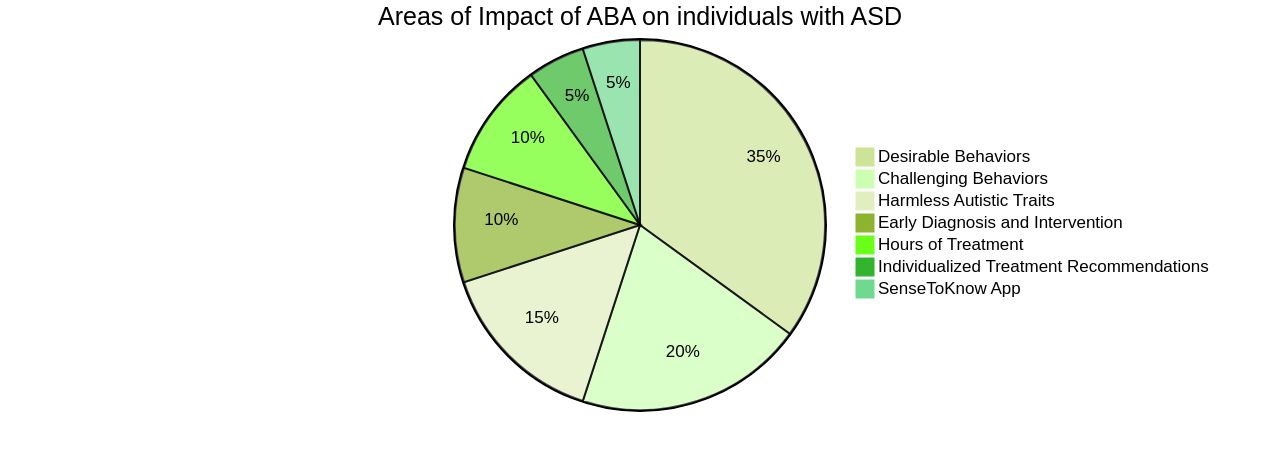
The Origins and Development of ABA
The field of Applied Behavior Analysis (ABA) has come a long way since its inception in the 1960s by Dr. B.F. Skinner. Initially, it was guided by behaviorism principles and used techniques like reinforcement and punishment to modify behavior.
However, over the years, ABA has diversified and incorporated a vast array of strategies and techniques. Among these are functional behavior assessment, discrete trial training, and naturalistic teaching approaches, along with the use of visual supports and structured environments.
Today, ABA is not a one-size-fits-all approach. It acknowledges the need to balance therapy with life, considering the impact of extensive hours of therapy on the family's financial situation, privacy, work-life balance, and relationships.
It also takes into account the necessity for treatment gains to be applicable to various environments. Yet, ABA, like many other therapies, has its share of controversies.
Some practitioners and parents vouch for its effectiveness, while some recipients of the therapy express reservations. The reality is that ABA might be beneficial in some cases and not in others. It underlines the need for a commitment to the scientific process and rigorous policy evaluation to determine its effectiveness accurately. It's also crucial to note that the ABA industry has been proactive in responding to changing needs and expectations. For instance, companies like Cortica and Gracent have made significant strides in the field, focusing on sustainability and growth. As the field of ABA continues to evolve, it's essential to keep the dialogue open, centering on the voices of all involved - the practitioners, clients, and families alike - to ensure the therapy is as effective and inclusive as possible.
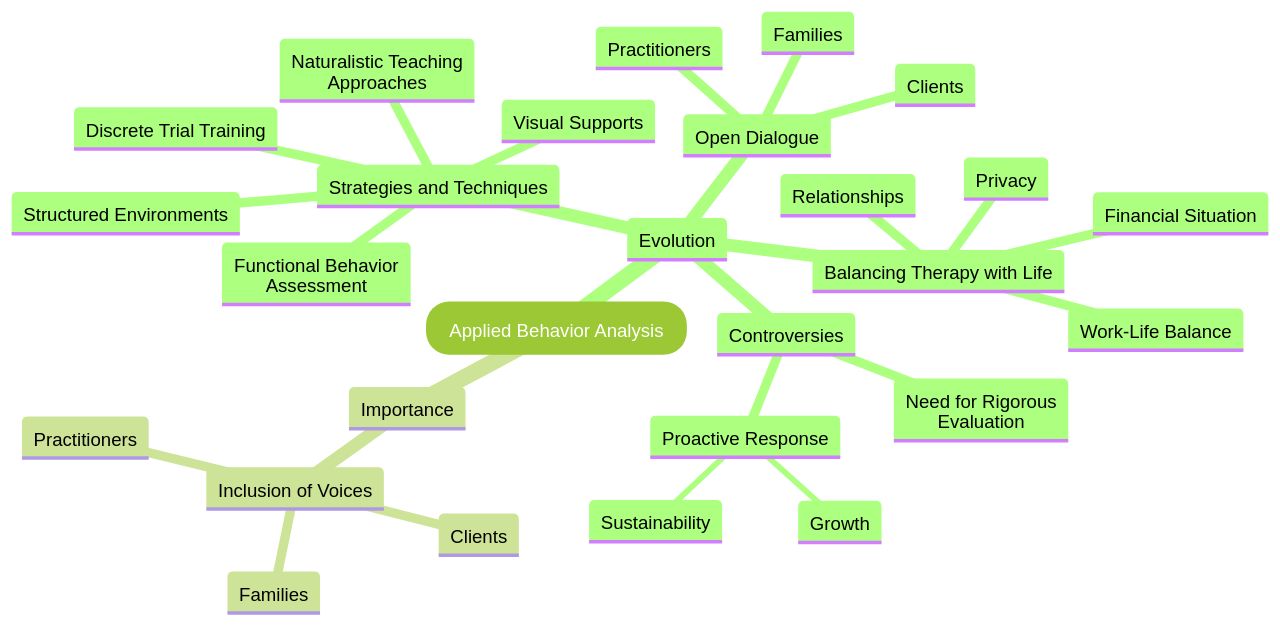
The Core Components of ABA
Applied Behavior Analysis (ABA) is not just about data collection, analysis, and deploying evidence-based strategies. It's a nuanced field that requires a flexible approach. The old saying 'more is better' does not necessarily hold true in ABA.
Recommendations may suggest anywhere from 5 to 40 hours per week of therapy, spanning 18 months to 5 years, but this can pose challenges for families. The financial impact, care coordination, and transition planning can become burdensome. The intrusion of having a therapist in your home daily can disrupt family dynamics and limit opportunities for social/community involvement.
Children who receive ABA in clinics face additional challenges, such as the commute and limited parental insight into their daily activities. Moreover, their treatment gains may not always translate to other environments. Therefore, striking a therapy-life balance is crucial for the child in treatment, their parents, and their siblings.
It's also worth noting that forcing a child to conform to 'normal' behaviors can lead to emotional and psychological harm, potentially resulting in serious mental health problems. ABA practices should be reflective and adaptable to each individual's needs, highlighting the importance of aligning with the neurodiversity paradigm. Ultimately, ABA should aim to provide better options that promote self-advocacy and help individuals navigate the world with their unique abilities.
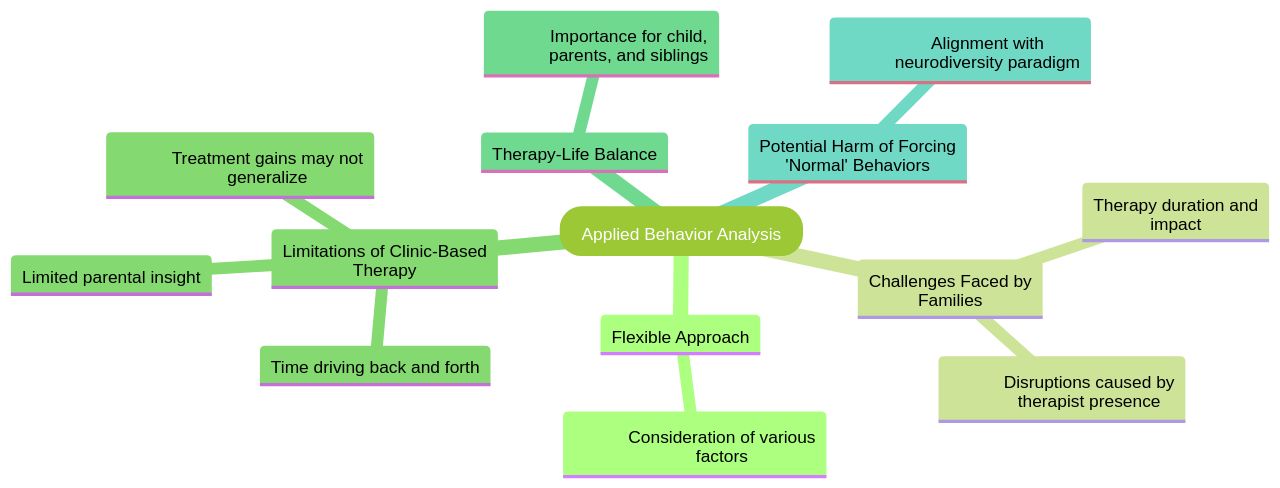
Assessment
ABA therapy initiates with an in-depth assessment of an individual's abilities, needs, and challenges. This comprehensive analysis involves a blend of caregiver interviews, direct behavioral observations, and the implementation of standardized tools.
The objective is to gather a full understanding of the individual's behavioral patterns, the environmental factors influencing them, and the specific goals for intervention. The assessment process often relies on open-ended prompts and broad follow-up questions, minimizing the examiner's participation.
This approach allows for a deeper understanding of the individual's interests, behaviors, and daily routines. For instance, topics of interest to the individual, such as nature walks, are used as conversation starters.
Another critical component of this assessment is the brief functional analysis. This analysis involves placing individuals in specific settings and recording their behaviors to identify patterns and differences.
Essentially, this analysis verifies, refines, or clarifies a hypothesis developed from the indirect and direct components of a functional assessment. However, it's important to remember that ABA is not a 'one size fits all' approach.
This is because recommendations can range from focused to comprehensive, with therapy hours varying from 5 to 40 hours per week, and for a period of 18 months to 5 years. The assumption that more hours will always translate to more progress may not always hold true. In fact, therapy-life balance is crucial for the child in treatment, their parents, and their siblings. Also, it's worth noting that ABA's benefits and costs are still a subject of discussion. Some believe in the therapy's effectiveness, while others question its use. The truth is, without a commitment to the scientific process and rigorous policy evaluation, we cannot definitively know whether, and for whom, the therapy works. Hence, it's essential to consider various factors that may lead to some undesirable effects that comprehensive treatment may have on families.

Behavior Intervention Plan (BIP)
In the realm of ABA therapy, individualized Behavior Intervention Plans (BIP) are crafted to cater to the unique needs of each individual. These plans detail specific objectives and goals, and delineate the strategies and tactics for behavior modification.
This could involve the use of positive reinforcement, gradual introduction and withdrawal of prompts, shaping behavior through gradual steps, and teaching alternative behaviors. However, it's crucial to remember that ABA therapy is not a 'one size fits all' solution.
The intensity of therapy, which can range from 5 to 40 hours a week for a period of 18 months to 5 years, needs to be carefully balanced with the individual's lifestyle and family dynamics. Overwhelming families with intensive therapy schedules can lead to financial strain, privacy concerns, and disruption of family relationships and community involvement.
Moreover, the location of therapy can greatly impact the individual and their family. Home-based therapy can intrude on family privacy and limit parents' ability to work, while clinic-based therapy can burden families with travel time and limit parents' insight into their child's daily activities.
There's also the risk that the skills gained in the clinic may not translate well to other environments. The balance between therapy and life is crucial not just for the individual undergoing treatment, but also for their parents and siblings. Striking this balance requires careful consideration of various factors and personalized planning. Additionally, the assumption that 'more is better' doesn't always hold true in ABA therapy. In fact, some evidence suggests that certain individuals with autism fare better with fewer therapy hours, contradicting this common assumption.
Data Collection and Analysis
ABA therapy is not a one-dimensional process but a multifaceted approach that heavily relies on data collection and analysis. The data collected is not just about the frequency, duration, and intensity of behaviors, but also about the antecedents and consequences that influence behavior.
This data is gathered through a unique blend of environmental and wearable sensors, forming an advanced monitoring system. These sensors enable the collection of a wide array of data, including biometric indicators and physical activity parameters, and even audio and video data.
The resulting datasets are then utilized to study and evaluate a child's behavior before, during, and after ABA therapy, thus facilitating automation of the ABA model's application. The data analysis part is crucial as it helps identify patterns, assess the effectiveness of interventions, and enables us to make necessary adjustments to the intervention plan.
However, it's important to remember that ABA therapy is not a 'one size fits all' approach. It requires a careful balance between the therapy and life. Recommendations of comprehensive treatments often raise concerns about its impact on the family’s financial stability, privacy, and overall family dynamics. Therefore, it's crucial to consider these factors to ensure that the therapy-life balance is maintained for the child in treatment, their parents, and their siblings.
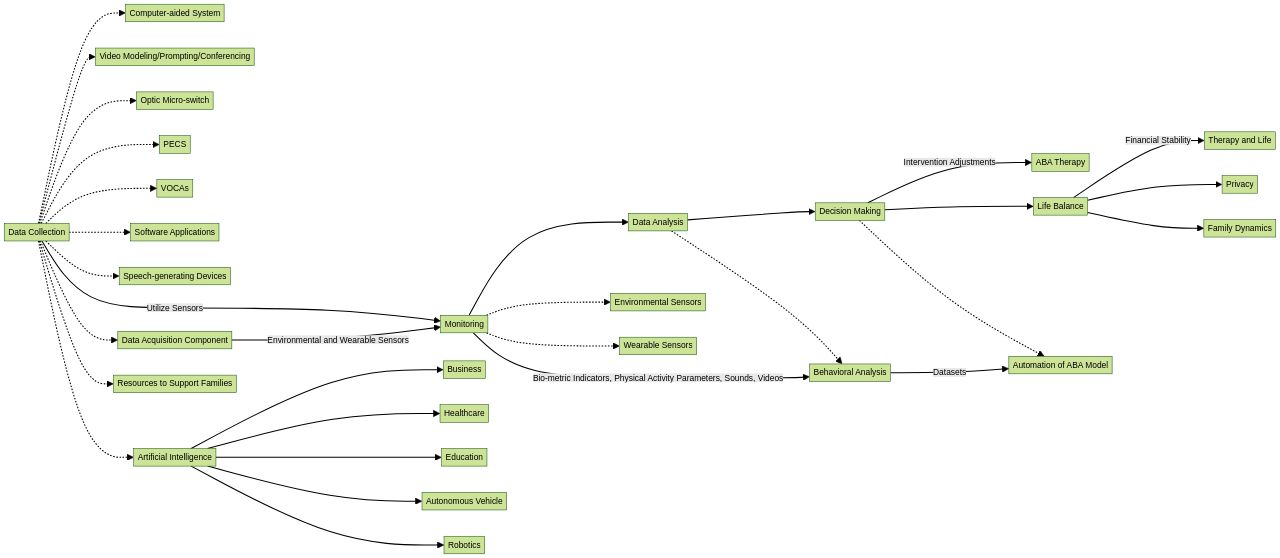
Skill Acquisition and Generalization
ABA therapy extends beyond merely addressing problematic behaviors; it is also instrumental in imparting and reinforcing valuable skills. These encompass communication abilities, social competencies, self-help techniques, and academic prowess.
The effectiveness of ABA is seen in a study conducted in a private clinic where a single participant exhibited significant reduction in problematic behavior and an increase in desirable behavior such as functional communication, delay tolerance, and compliance. This improvement was achieved through a comprehensive treatment plan that included teaching functional communication response, tolerance response, and fostering compliance with varying levels of demands.
Moreover, ABA therapy is not a rigid, one-size-fits-all approach. It takes into account the individual's unique circumstances and tailors the therapy accordingly.
For instance, the SKOLKONTAKT™ program in Stockholm, Sweden, provides individual support, small-class sizes, and higher staff-to-student ratios. These measures, coupled with implementing individual action plans (IAPs), demonstrated the adaptability of ABA therapy in diverse settings.
However, it's crucial to acknowledge the potential challenges associated with intensive ABA therapy. There are concerns around the substantial time commitment, financial implications, and potential intrusion of privacy. Therefore, striking a balance between therapy and life is vital for the child, their parents, and siblings. Finally, it's important to note that while ABA therapy has proven beneficial in many instances, it may not work for everyone. The key lies in a commitment to the scientific process, rigorous policy evaluation, and a comprehensive understanding of the therapy's impacts. This approach ensures that ABA therapy continues evolving to cater to the unique needs of each individual while enhancing their quality of life.
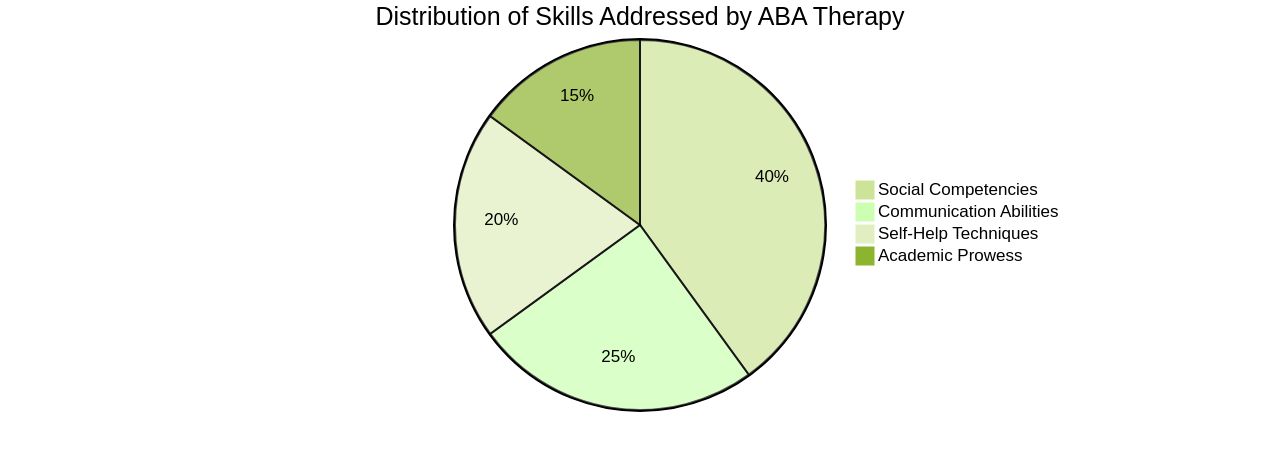
Family and Collaborative Approach
In the world of Applied Behavior Analysis (ABA) therapy, the principle of collaboration and family involvement is paramount. It's recognized that every child with autism has unique needs, and thus, their treatment program must be tailored specifically to them.
This includes a thorough assessment by a Board Certified Behavior Analyst (BCBA), setting measurable goals, and closely monitoring progress to adjust strategies as needed. However, it's also understood that an effective ABA program goes beyond the child and involves the entire family.
The implementation of ABA strategies in various settings, particularly at home, is crucial. To ensure this, ABA professionals work hand in hand with parents and caregivers, providing them with the necessary training, support, and guidance.
This approach ensures a consistent and continuous intervention across different environments, promoting the child's progress and development. But it's important to note that this collaboration must be balanced.
The notion of 'one size fits all' doesn't apply to ABA. The intensive nature of ABA, with recommendations often exceeding 30 hours per week, can pose several challenges for families, including financial strain, disruption of normal routines, and potential strain on familial relationships. Therefore, maintaining a therapy-life balance is critical not just for the child undergoing treatment, but also for their parents and siblings. In conclusion, the success of ABA therapy relies on a harmonious partnership between therapists and families, with open communication being key. Hearing positive experiences from other families can be encouraging, highlighting the challenges overcome and the joy and hope that comes with progress.
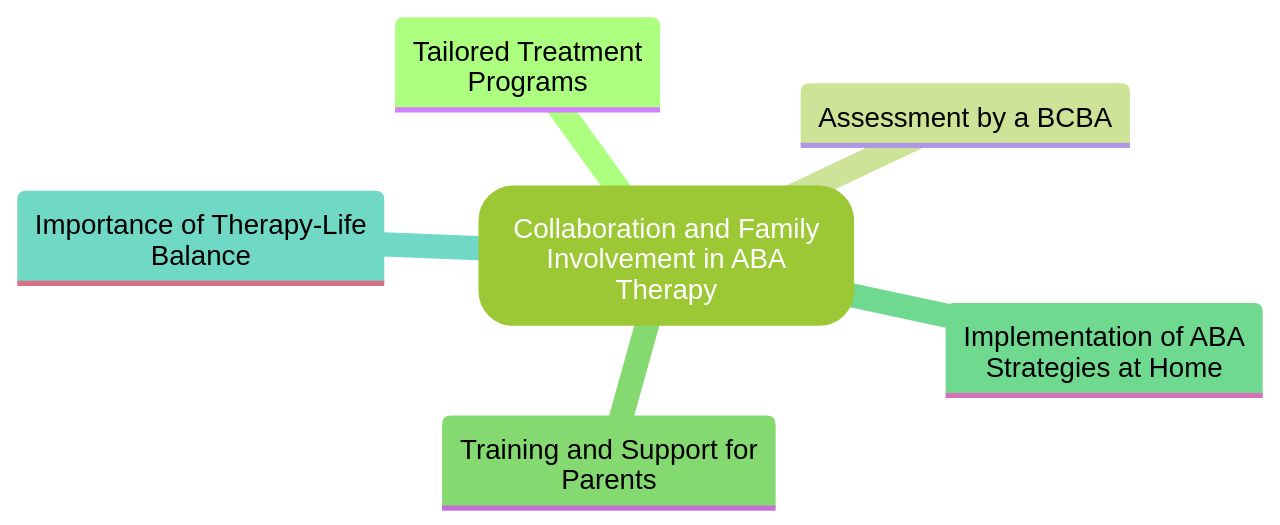
Conclusion
In conclusion, Applied Behavior Analysis (ABA) is a data-driven methodology that empowers Parent Advocates to support individuals with developmental disabilities. ABA fosters desirable behaviors and minimizes challenging ones through personalized strategies.
However, it's important to strike a therapy-life balance for the child in treatment and their family. ABA has evolved over the years, incorporating various strategies and techniques.
Collaboration with families is crucial to ensure treatment gains are applicable to different environments. A flexible approach that aligns with the neurodiversity paradigm is essential.
Assessment plays a vital role in developing personalized intervention plans. ABA is not a one-size-fits-all approach, and considering various factors is key to avoiding undesirable effects on families.
Behavior Intervention Plans (BIP) in ABA are tailored to each individual's needs. Maintaining a therapy-life balance is important for families, whether it's home-based or clinic-based therapy.
Data collection and analysis are integral but should consider the therapy-life balance. Striking a balance between therapy intensity and lifestyle is crucial.
ABA focuses on skill acquisition and generalization beyond addressing problematic behaviors. Striking a balance between therapy and life is vital for families, and intensive therapy may not work for everyone. Collaboration with families is paramount in ABA therapy. Effective programs involve thorough assessments, measurable goals, continuous progress monitoring, and training for parents and caregivers. Overall, ABA empowers Parent Advocates in navigating challenges and ensuring their children's well-being. Open communication between therapists and families plays a crucial role in achieving success in ABA therapy. Sharing positive experiences provides encouragement and hope in the progress made through ABA interventions.




